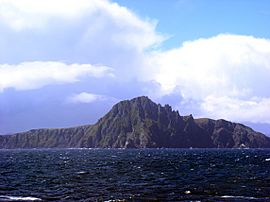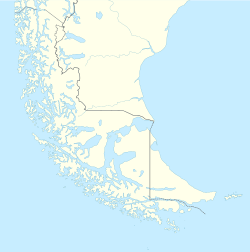Hornos Island facts for kids
|
Native name:
Isla Hornos
|
|
|---|---|

The Hornos Island
|
|
| Geography | |
| Coordinates | 55°56′39″S 67°16′51″W / 55.944078°S 67.280925°W |
| Archipelago | Tierra del Fuego |
| Adjacent bodies of water | Pacific ocean / Atlantic ocean |
| Area | 25.1 km2 (9.7 sq mi) |
| Administration | |
| Region | Magallanes |
| Province | Antártica |
| Commune | Cabo de Hornos |
| Demographics | |
| Population | 5 (2019) |
| Additional information | |
| NGA UFI= -884347 | |
Hornos Island (also called Spanish: Isla Hornos in Spanish) is a small island at the very southern tip of South America. It belongs to Chile. Most people know it because it's home to Cape Horn, a famous landmark for sailors. While many think it's the southernmost island of South America, the Diego Ramírez Islands are actually a bit further south. Hornos Island is part of a group called the Hermite Islands, which are part of the larger Tierra del Fuego archipelago.
The Chilean Navy has a station on the island. This station includes a home, a building for supplies, a small church, and a lighthouse. Near the station, there's a special memorial. It has a big sculpture of an albatross. This memorial honors sailors who lost their lives trying to sail around Cape Horn.
Hornos Island is located within the Cabo de Hornos National Park.
Contents
Nature and Wildlife on Hornos Island
Hornos Island is mostly covered by Magellanic moorlands. These are open, wet areas with low-growing plants. In places exposed to strong winds, you'll find tough grasses and short shrubs. These plants grow close to the ground to avoid the wind. Taller trees can only grow in spots that are protected from the wind. The world's southernmost tree, a Nothofagus betuloides (also known as a Magellan's beech), grows on Hornos Island.
The island also has many penguin colonies along its coast. There are no land predators here, which makes it a safe place for penguins to live and raise their young.
People and History
In 2019, only five people lived on Hornos Island. This small group included the lighthouse keeper, his wife, and their three children.
Hornos Island is also important for understanding early human history. The world's southernmost archaeological site was found here in 2019. This site showed signs of early human activity, including harpoon points, animal bones that had been cut, and a place where people cooked. This tells us that humans lived and hunted in this very remote area a long time ago.
Island Geology
The main rock type on Hornos Island is Cretaceous granite. In the northwest part of the island, you can also find Jurassic volcanic rocks. The lower areas of the island are filled with peat moss. This is a type of moss that grows in wet, boggy areas and forms thick layers over time.
Hornos Island Climate
The climate on Hornos Island is generally cool and windy.
- The average temperature is about 5.3 °C (41.54 °F).
- The highest temperature recorded was 20.5 °C (68.9 °F) in February 1996.
- The lowest temperature recorded was −14.5 °C (5.9 °F) in June 1992.
- The air is usually very humid, with an average relative humidity of 86.4%.
- Winds are strong, with an average speed of 84 knots. The strongest wind recorded was 119 knots in August 1995.
- The island receives a good amount of rain, with an average of 697.5 mm per year. The most rain in one year was 1263.2 mm in 1990.
See also
 In Spanish: Isla Hornos para niños
In Spanish: Isla Hornos para niños


